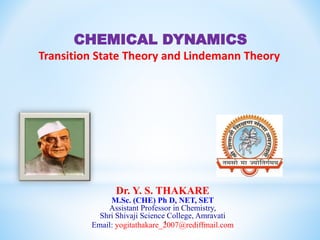
Chemical dynamics, intro,tst, lindemann theory
- 1. 1 Dr. Y. S. THAKARE M.Sc. (CHE) Ph D, NET, SET Assistant Professor in Chemistry, Shri Shivaji Science College, Amravati Email: yogitathakare_2007@rediffmail.com CHEMICAL DYNAMICS Transition State Theory and Lindemann Theory
- 2. Transition state theory (TST) Activated complex theory (ACT) Absolute reaction rate Theory (ARRT) Henry Eyring 1901 - 1981 E activation energy Eyring, Polany and Evas in 1935
- 3. Henry Eyring, M. Polyani & M G Evans
- 5. Transition State Theory This theory is given by Eyring, Polany and Evas in 1935. According to this theory not only collision between reacting molecule forms a product but there is the existence of transition state (T.S.) or activated complex (A.C.) which decompose to give the product. Consider the bimolecular reaction In collision theory fast approaching A2 and B2 slow down due to gradual repulsion between their electron cloud. In this process K.E. of two molecules is converted in to P.E. As molecule come closer there is interpenetration of their electron cloud which allow the rearrangement of valence electron. The partial bonds between the atoms A and B is formed with weakening the bond between A2 and B2. This leads to the formation of an A.C. or T.S.
- 6. Assumption of transition state theory i) As reacting molecule approach to each other bond distance changes these changes are accompanied by the energy changes ii) The reactant molecules changes into activated complex or transition state iii) The activated complexes are formed by bonding of reactant molecule with necessary rearrangement of valence bond and energy of the reactant is unimolecular the reactant molecules may produced activated complex by rearrangement of atom and redistribution of energy iv)The activated complex remain in equilibrium with reactants and its potential energy is maximum finally the activated complex decompose into product v)The activation energy of reactant is the additional energy which the reacting molecule must acquired to form the activated complex
- 7. The two molecules A2 and B2 must receive an additional energy called as the activation energy which converted the molecule in to activated complex (A.C.). The activated complex is a special molecule in which one vibrational degree of freedom is converted in to translational degree of freedom along the reaction co- ordinate. It must be remembered that the A.C. is not nearly intermediate in the process of the breaking and making of the chemical bond. It is unstable because it is situated at maximum P.E. barrier separating a product from reactant. There are two types of reaction depending on P.E. of product. P.E. of product may be less than that of reactant. P.E. of product may be more than that of reactant
- 8. “Reaction Coordinate” Diagram (for a one-step atom transfer) Not a realistic trajectory, but rather a sequence of three species Starting Materials Products Transition “State” G each with H and S, i.e. Free Energy (G)
- 9. KE can be converted into PE and vice versa When the child is at points (a) and (c) they have only PE; at point (b) only KE. Total energy is conserved (PE + KE = constant). When fully compressed or extended only PE; at natural length only KE. Total energy is conserved. The potential energy that resides in chemical bonds is called chemical energy
- 10. DERIVATION OF EYRING EQUATION OR THERMODYNAMIC FORMULATION OF ACTIVATED COMPLEX THEORY Which determine or measure the probability that of the activated complex molecule passes over the energy barrier will keep on going and not to return back.
- 12. Evaluation of standard entropy of activation and standard entropy of activation
- 14. H H2 H2 H HHH H H H Henry Eyring (1935) Dissociation followed by association requires high activation energy. SLOW Make-as-you-break “displacement” is much easier. FAST Application of transition state to reaction between atoms and molecules
- 16. THEORIES OF UNIMOLECULAR REACTION OR LINDEMANN THEORY Lindemann (1922)
- 19. Limitation of Lindemann-Christiansen Theory and its explanation
- 20. Thank you for your attention!
